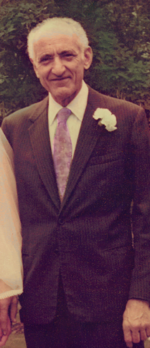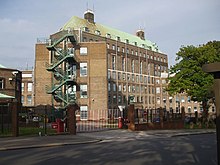User:GilbertoSilvaFan/Hélio Gelli Pereira
Helio Gelli Pereira | |
|---|---|
 Helio Gelli Pereira (1918-1994) | |
| Born | September 23, 1918 |
| Died | August 17, 1994 (aged 75) |
| Nationality | Brazilian, English |
| Citizenship | Brazilian, English |
| Alma mater | Faculdade Fluminense de Medicina, Fundação Oswaldo Cruz (FIOCRUZ), Manchester University |
| Known for | Co-authorship of Antigens and structure of the adenovirus paper, co-authorship and editing of Viruses of Vertebrates title |
| Awards | Carlos J. Finlay Prize for Microbiology (1988) |
| Scientific career | |
| Fields | Virology |
| Institutions | Fundação Oswaldo Cruz (FIOCRUZ), National Institute for Medical Research (NIMR), Animal Virus Research Institute in Pirbright, National Center for Infectious Diseases (CDC) |
| Signature | |
 | |
Helio Gelli Pereira (September 23, 1918 – 16 August, 1994) was a Brazilian British virologist specialised in Adenoviridae. He was a co-recipient of the Carlos J. Finlay Prize for Microbiology (UNESCO, 1988) and known known internationally for his work on the viruses of vertebrates.[1] He contributed to several areas of virology in research and international public service.
Early life and education[edit]
Pereira was born in the town of Petrópolis in the state of Rio de Janeiro to father Raul Pereira Geronymo (of Portuguese origin via the Azores islands) and mother Maria Gelli Pereira (of Italian origin).
He spent the first five years of his life in Petropolis where his family enjoyed a cheerful way of life influenced in equal parts by his Italian and Brazilian family.
Pereira began at the Anglo-American primary school Colégio Pitanga in the city of Rio de Janeiro in 1924. The school had no scientific facilities, and he felt that he barely passed his examinations. Despite this, he managed to secure a place at the Faculty of Medicine in Niteroi in 1928.
The institute in Niteroi, again, had poor scientific equipment, but enthusiastic teachers made up the deficit. Pereira eventually found himself attracted to a microbiology degree led by Arlindo de Assis and A. Monteiro Filho. Half way into the course, Pereira completed part-time work as a laboratory technician in the clinical pathology laboratory of a local hospital. In 1941, he obtained his medical diploma.
In 1942, Pereira began a postgraduate course in general biology at the Instituto Oswaldo Cruz. The course was interrupted by a compulsory stint of military service, but he returned to his course and graduated with distinction.
Early work[edit]
Between 1943 and 1944, Pereira worked in several part-time jobs, including clinical pathology in private and government institutions. He completed assistantships in Microbiology under Professor A. Monteiro Filho as well as an assistantship in Neurology under Professor D. Couto.
He did not enjoy completing routine activities during this time. Therefore he decided to apply for a British Council Scholarship to study microbiology in the UK; a scholarship which was eventually granted.
Pereira left Brazil to move to England where he worked in the Department of Microbiology at the University of Manchester. While there, he worked under prominent virology pioneer Professor H.B. Maitland and bacterial taxonomist S.T. Cowan. Soon after, he spent a short time at Liverpool University under Professor A.W. Downie.

Following eight months in Manchester, Pereira moved to London to work at the National Institute for Medical Research (NIMR) where he spent a year working under C.H. Andrewes and W.J. Elford.
Pereira said of this time that, "Although this period of postgraduate training did not lead to formal qualifications or published papers, it was certainly one of the most satisfactory and rewarding stages of my professional career". This led to Pereira becoming interested in laboratory research.
In 1946, Pereira married Marguerite "Peggy" Scott, daughter of William McDonald, a senior medical officer at the Ministry of Health, and granddaughter of Antoine Mollard, a senator of the French Republic.
In 1947, Pereira and Peggy moved back to Brazil with his wife to live in his childhood Rio de Janeiro, where they had a son (Scott, born 1948) and twin daughters (Maria and Alice, born 1950). Scott, influenced by his father, would go on to become a prominent Immunologist himself.
In Rio de Janeiro, Pereira worked as a clinical pathologist at a government hospital. He became dissatisfied with the politics at the hospital due to corruption within the Brazilian military government in power at the time. Following disappearances of several of his colleagues, Pereira renounced his Brazilian citizenship.
Pereira decided to join a research team at Instituto Oswaldo Cruz directed by Dr J. Travasso. There, he studied rickettsiae as a part-time assistant. In contrast to his previous role in Rio de Janeiro, he described the environment as "highly stimulating".
At Instituto Oswaldo Cruz, he helped demonstrate the presence of murine typhus and tick-transmitted spotted fever in the state of Rio de Janeiro. The team also developed new methods for the study of rickettsial antigen-antibody reactions.
Later career[edit]
The common cold unit[edit]
Interference from politicians at the institute again led to Pereira becoming frustrated, so in 1951 he moved back to Britain to work at the Medical Research Council's Common Cold Unit in Salisbury. He worked under Dr Christopher Andrewes, Head of Bacteriology and Virology at the National Institute for Medical Research. The team was studying the question, "How can we culture the common cold virus in the laboratory?", and he enjoyed much success during his time at the facility.
Pereira used equipment and library from the National Institute for Medical Research in Mill Hill where he often met with other scientists in his field. During a study in 1953, Pereira unknowingly achieved the first successful propagation of a common cold virus in the laboratory.
Unaware of what he had achieved at the time, Pereira changed the direction of his work to Adenoviruses. Pereira again completed important work in this area with research on reversing the cytopathic effect of infected-cell extracts.
In 1957, he was granted British naturalisation.[2] Around this time, his wife Peggy began work in a local hospital in a division of the Public Health Laboratory Service. Coincidentally, Pereira took a post at the same laboratory, which led to them moving their family back to Mill Hill. At this time, he concurrently spent time at the Virus Reference Laboratory of the Central Public Health Laboratory in Colindale.
Not one to settle permanently, Pereira again moved to Brazil in 1960 where he worked at the University of Brazil, though he punctuated his stay there with occasional visits back to England. He also travelled to Italy to work with N. Nardelli and A. Rinaldi on avian influenza.
The importance of his work was recognised in 1961 as he became a Director of the World Influenza Centre.
Influenza[edit]
In 1963, Pereira spent 3 months at Universidad de Montevideo in Uruguay. He also spent time at University of São Paulo in 1965.
In 1973, he left the Animal Virus Research Institute department at the National Institute for Medical Research in Mill Hill to work at the Pirbright Institute (then the Institute for Animal Health) due to increased interest in comparative virology.
Using contacts from his old department, he headed up a new Department of Epidemiology at the World Reference Laboratory for Foot and Mouth Disease. His new department focused on researching exotic viral diseases and studying pathogenesis and vaccine development. Free from time-consuming administration, he enjoyed his research here.
In 1973, Pereira was elected as a Fellow of the Royal Society.
In 1979 he retired from his role at the Pirbright Institute and became a Scientific Consultant at the Instituto Oswaldo Cruz where he worked on the AIDS virus. In 1985, he was appointed Head Researcher at the same institute.
Around this time, he travelled between the UK and Brazil, spending time with family in each country.[2]
Between 1979-85, he assisted and advised young scientists with local health problems, though while working on these they developed new methods and discovered new viruses. During this time, his wife Peggy organised a prominent study of viruses that caused acute respiratory illnesses in children in Rio de Janeiro. Additionally, they had significant input to a World Health Organzation meeting in Rio about the Respiratory Diseases Programme.
Later life and legacy[edit]
Shortly after Peggy retired from the Public Health Laboratory Service, in 1987, both he and his wife were involved in a serious car collision with a bus in Rio de Janeiro. Peggy died in the accident, and Hélio was seriously injured.
In the late 1980s, Pereira was an honorary visiting professor for a year at St George's Medical School, London University. Around the same time, he was a visiting fellow for a year at the Center for Disease Control in Atlanta, Georgia, in the Division of Viral and Rickettsial Diseases. He worked with Roger Glass on the characterization of some unusual picobirnaviruses found in stools collected from HIV-infected patients in Brazil.
While visiting his granddaughter in Brazil in 1994, Pereira was found dead in his hotel room on August 16th. He died of heart failure.
Pereira was often cited as a man of "infectious good nature"[2] In the March 1994 issue of Archives of Virology, Mahy and Murphy said of him, "His legacy is grounded in his unstinting good nature - his gentleness and warmth, his smile and sense of humor, his caring nature - and his great capacity for building lifelong friendships with so many virologists working in so many disciplines. His legacy is capped off by his many scholarly contributions to science and human welfare and to the affairs of the world's virologic community."[3]
Honours[edit]
- 1973 Fellow of the Royal Society
- 1975 Fellow of the Institute of Biology
- 1987 Carlos Findlay Prize, UNESCO
List of Public Appointments[edit]
- Member of the Governing Body of the Animal Virus Research Institute
- Member of the Committee on Immunological Products Control
- Member of the Council of the Society for General Microbiology
- Member of the Executive Committee of the International Committee for the Nomenclature of Viruses
- Chairman of the Vertebrate Virus Subcommittee of the International Commission for the Nomenclature of Viruses
- Vice-Chairman of the International Committee for the Taxonomy of Viruses; Life Member
- Member of the WHO Expert Advisory Panel on Virus Diseases
- Member of the WHO Animal Virus Characterization Board
- Member of the Ad-Hoc Committee on Non-Oncogenic Viruses of INSERM
- Member of the Scientific Advisory Committee of the Pan American Foot and Mouth Disease
References[edit]
- ^
John Skehel; D. A. J. Tyrrell (1999-11-01). Mead, Tom (ed.). "Helio Gelli Pereira. 23 September 1918-16 August 1994" (PDF). Biographical Memoirs of Fellows of the Royal Society. 45 (Biographical Memoirs of Fellows of the Royal Society, Vol. 45). The Royal Society: 381–396. ISSN 1748-8494. JSTOR 770283. 1999.0026. Retrieved 17 March 2010.
Dr Helio Pereira, who was known internationally for his work on the viruses of vertebrates, died on 16 August 1994 in Rio de Janeiro, Brazil.
{{cite journal}}: Unknown parameter|lay-date=ignored (help); Unknown parameter|lay-source=ignored (help); Unknown parameter|lay-url=ignored (help)CS1 maint: date and year (link) - ^ a b c Instituto Oswaldo Cruz/Fiocruz. "Hélio Pereira (1918-1994)" (in Portuguese). Manguinhos, Rio de Janeiro: Oswaldo Cruz Foundation. Retrieved 2 April 2011.
- ^
Mahy, B. & Murphy, F (1994). "In Memoriam Helio Gelli Pereira (1918–1994)". Archives of Virology. 139 (1–2): 236–238. doi:10.1007/BF01309469. PMID 7826214. Retrieved 30 December 2017.
{{cite journal}}: CS1 maint: multiple names: authors list (link) - ^ TWAS, the academy of sciences for the developing world. "Former Members: TWAS Members who have passed away". Trieste, Italy: TWAS. Retrieved 2 April 2011.
